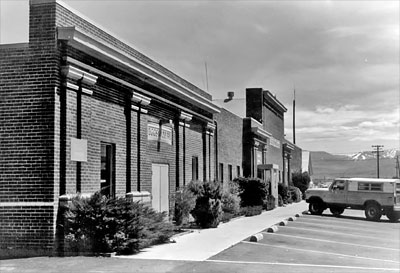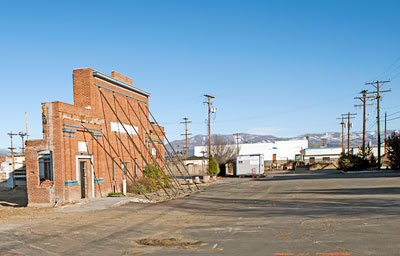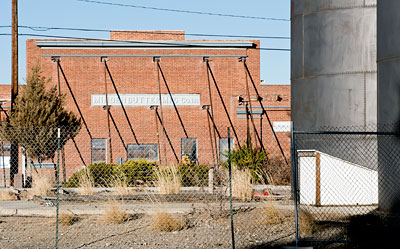National Register of Historic Places in Douglas County
Minden Butter Manufacturing Company
1617 Eighth Street
Built 1916
Minden
The Minden Butter Manufacturing Company, established in 1908, was one of Minden's principal industries in the early 20th century. The company marketed Carson Valley produce, particularly butter, under the Windmill brand.
The primary market was the San Francisco Bay Area, made possible by the establishment of a Virginia & Truckee Railhead in Minden.
This building was constructed in 1916 by H. F. Dangberg, Jr. as a butter processing plant. It was designed by Frederick J. DeLongchamps and is one of five major commercial and public buildings designed by DeLongchamps in Minden between 1900 and 1920. Built as a food processing plant, the building now serves as a light manufacturing plant for Bentley-Nevada Company. The building retains its overall architectural integrity and is currently used as offices for the Bentley-Nevada Company. The Minden Butter Manufacturing Company occupies a
Source: Adapted from the NRHP nomination submitted in 1986.

When we photographed the remains of the Minden Butter Manufacturing Company, a sign on the property announced that the façade would be incorporated into the new Bently Heritage Estate Distillery.

Façadism
Wikipedia defines Façadism (or Façadomy) as the practice of demolishing a building but leaving its façade intact for the purposes of building new structures in it or around it.
The International Charter for the Conservation and Restoration of Monuments and Sites (The Venice Charter of 1964) provided the doctrinal foundation for the modern preservation movement.
Although the United States did not participate in the preparation of the charter, the charter provided the basis for the Secretary of Interior's Standards for Historic Preservation. US/ICOMOS was founded in the 1960s to foster heritage conservation and historic preservation.
Article 1 of the Venice Charter
The concept of a historic monument embraces not only the single architectural work but also the urban or rural setting in which is found the evidence of a particular civilization, a significant development or a historic event. This applies not only to great works of art but also to more modest works of the past which have acquired cultural significance with the passing of time.
Article 7 of the Venice Charter
A monument is inseparable from the history to which it bears witness and from the setting in which it occurs. The moving of all or part of a monument cannot be allowed except where the safeguarding of that monument demands it or where it is justified by national or international interest of paramount importance.
Article 13 of the Venice Charter
Additions cannot be allowed except in so far as they do not detract from the interesting parts of the building, its traditional setting, the balance of its composition and its relation with its surroundings.
Paul Golderberger, writing in the New York Times on 15 July 1985 (Façadism on the Rise: Preservation or Illusion?), gives an argument against urban façadism.
For façadism holds out a great temptation. It seems, on the surface, to give both sides what they want. The small, older buildings valued by preservationists appear to be saved, while the large new ones developers seek can still be built.Façadism in San Francisco:But while façadism pretends to a certain earnestness, it is at bottom rather pernicious. For the compromise it represents is not really preservation at all. To save only the facade of a building is not to save its essence; it is to turn the building into a stage set, into a cute toy intended to make a skyscraper more palatable. And the street becomes a kind of Disneyland of false fronts.
- Belli Building, 722 Montgomery Street
- Borel and Company, 440 Montgomery Street
- Engine Company No. 14 , 1047 McAllister Street
- Genella Building, 726-728 Montgomery Street
- Hoffmann Grill Building, 619 Market Street
- Italian American Bank, 460 Montgomery Street
- South End District
- United States Mint & Subtreasury, 608 Commercial Street
- Minden Butter Manufacturing Company, Minden, NV


